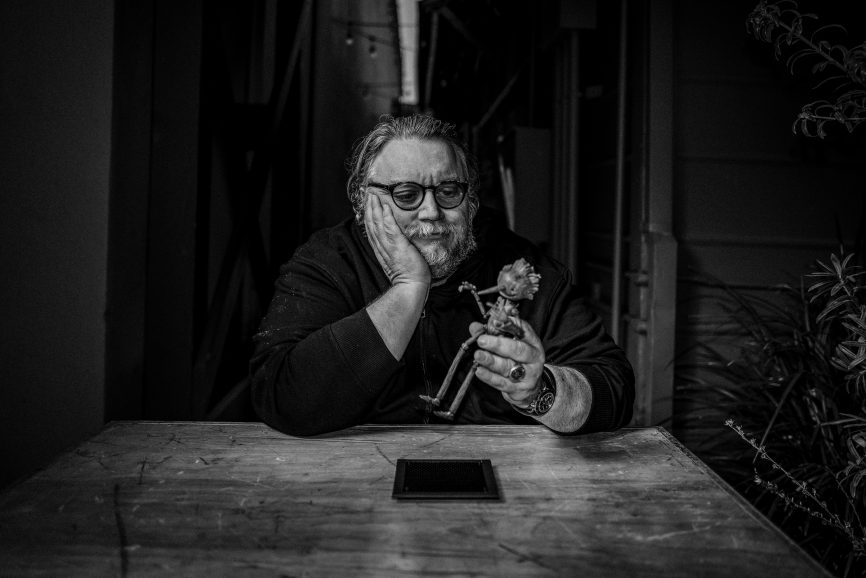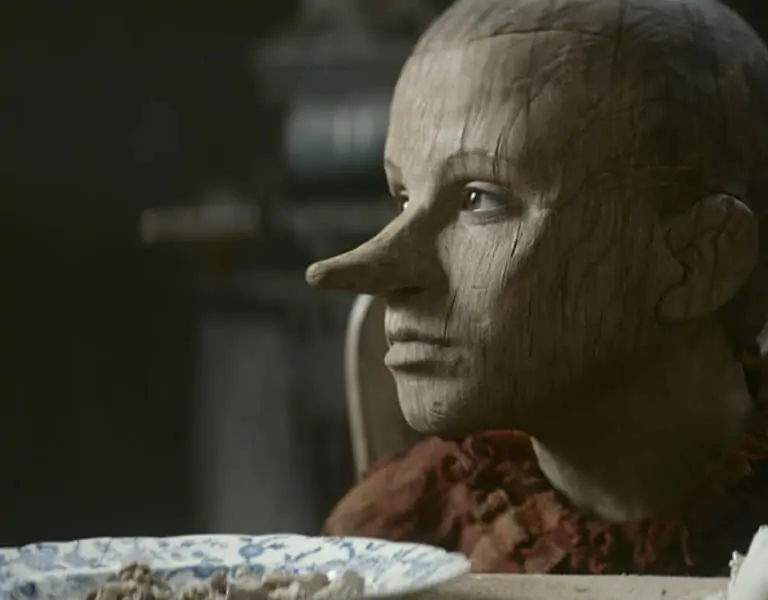FRESH TAKE ON A FAIRYTALE
The magical power of stop motion animation made it the picture-perfect medium to tell a tale close to director Guillermo del Toro’s heart. Helping heighten the emotion and drama of the reimagining of Pinocchio by combining methods rarely seen in stop motion was master craftsman and cinematographer, Frank Passingham.
“If you’re working with puppets and stop frame animation, you want the audience to believe they’re watching real people. Once you’ve conveyed the puppets are living breathing entities, you can go beyond that using naturalistic lighting enhanced in various ways to create drama,” says Frank Passingham (Kubo and the Two Strings, Chicken Run), the cinematographer who lensed Guillermo del Toro’s Oscar- and BAFTA-nominated, Golden Globe-winning version of fairytale Pinocchio.

As expected from a del Toro creation, the film is a carefully crafted, unique and magical take on the familiar story of a puppet who dreams of becoming a real boy. The fable – which has lived in many incarnations – is close to the director’s heart and one he has dreamt of bringing to the screen from a young age.
“I longed to make a film full of light that would explain how brief and significant we are in our time with each other – and I wanted to do it with heartbreaking beauty and rendered by the most human craftsmanship. So, I chose one of the most delicate, artisanal forms of our art form – stop motion animation – and pushed it as much as possible,” says del Toro, who co-directed the film alongside Emmy award-winning stop motion veteran, Mark Gustafson (Fantastic Mr. Fox, The Adventures of Mark Twain).
For del Toro, who has a lifelong love of animation, stop motion is special because the bond between an animator and a puppet is intimate, almost sacred. “And it’s linear – you are shooting, frame by frame, a consecutive action, in real sets, with real props and real cinematography. In live action film, you provoke the “accident” … and hope to capture it on film,” he says. “In animation, you create it – the wind moving the hair, the flap of a coat, a misstep, they’re all pre-planned and executed to bring the world into our puppets – to animate to make them live and feel.”

Passingham had not read a script as powerful as del Toro’s reimagining and was “incredibly excited” to work on it. “There were the connections with Carlo Collodi’s original 1883 fantasy novel, but because this version places the narrative between the First and Second World War and touches on what was happening politically, it’s such a powerful story and relevant to the world today,” says the cinematographer, speaking from New York where he was involved in an exhibition at the Museum of Modern Art – Guillermo del Toro: Crafting Pinocchio – dedicated to the artistry on show in the Netflix production.
When Passingham was approached about the film, he was yet to meet del Toro and knew but had not worked with co-director Gustafson. “The cinematography wasn’t a done deal at that point, so they flew me to LA to meet Guillermo at the Netflix building,” says Passingham. “It was a fantastic meeting; he puts you at ease so you feel you can totally be yourself and talk to him about anything.”

The colour script was of utmost importance from their initial conversation when del Toro asked Passingham to tell him about his process. “I said one of the first things I like to get involved with is the colour script and Guillermo leant across the table and said, ‘Not if I beat you to it,” which made me laugh,” says Passingham. “I told him I knew how particular he was about colours and that it’s really important to a cinematographer too because of all the emotion that can come from colour. It’s one of the things I like to be really closely involved with. Guillermo replied, ‘Absolutely, and I look forward to collaborating with you on that.’”
Passingham worked with production designers Guy Davis and Curt Enderle and art director Robert DeSue to create a colour script for the film’s naturalistic and Limbo worlds. They referred to a vast catalogue of images to ensure the colour palette was accurate and produced the correct emotional note for each scene before presenting it to the directors. Making such decisions early was useful when shooting out of sequence, informing the team when colours would feature as they travelled through the story.
Passingham was particularly satisfied with the use of red – a colour del Toro highlighted as being significant in the film – in a scene when Pinocchio’s father Geppetto discovers his son has failed to make it to school. “You must always consider when to use hard light and soft light in these situations. What we chose in the colour script proved to be absolutely right in terms of hue and quality of light for that sequence when a reddish aura appears at the end of the day,” says the cinematographer.
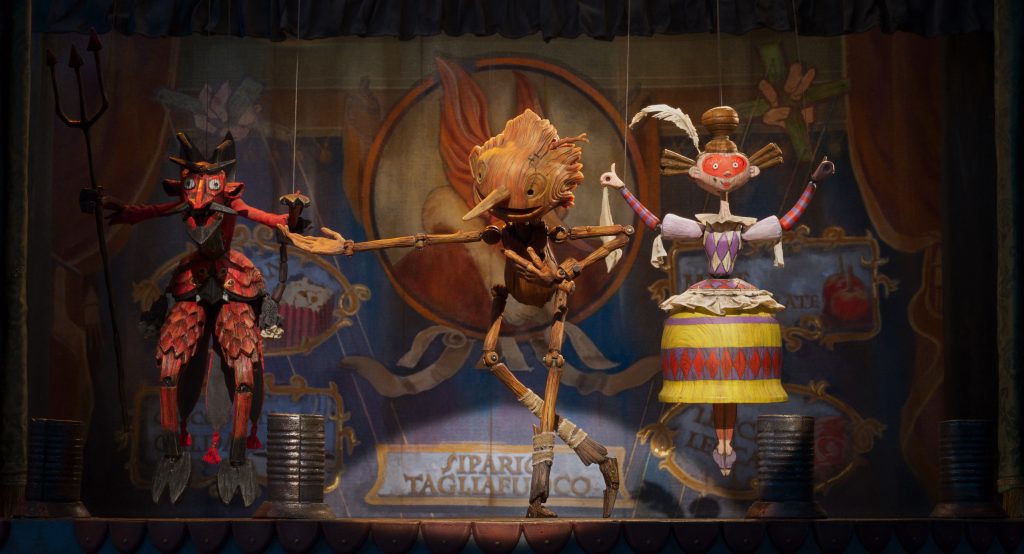
Voyage of discovery
On previous productions, when Passingham walked into the studio a team of lighting camera people and motion control team were already on board. This time he had an empty warehouse and needed to assemble a team, an opportunity he welcomed because he “could get the best people I knew or had worked with before from around the world.”
Weekly half hour meetings between the carefully assembled lighting camera team, electricians, gaffers, motion control team, and assistant cameras were valuable when exploring problems that may be encountered and any improvements that could be made to techniques. Passingham selected a movie of the week, and the crew referenced additional films that might inspire, highlighting scenes that used techniques which could create drama. “We wanted to come up with something which was very much our own, of course, but these camera meetings were really important and a great way for the team to bond,” he says.
Meetings outside of that focused on defining key characters. Printing the faces of two of the puppets – Pinocchio and evil Count Volpe’s monkey assistant Spazzatura – demanded a technique called rapid prototyping. “Pinocchio has wood grain running through him so it was apparent a mechanical puppet would not be suitable,” elaborates Passingham. “It had to be rapid prototyping to keep all the grain in the same format, so as he speaks the grain stays in the right place. Spazzatura’s face was also very complex.”
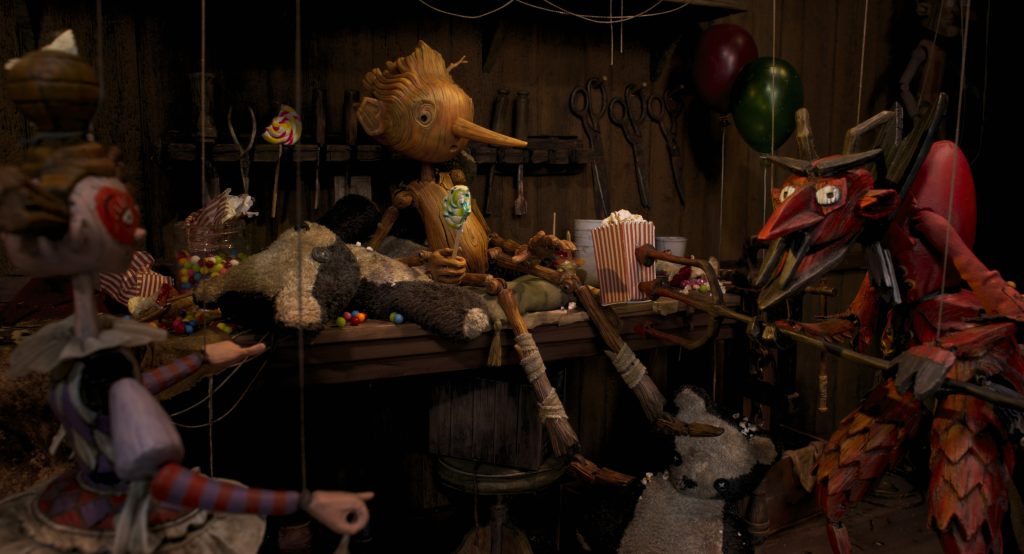
The way puppets were painted and lit was examined in detail. Soon after being painted, characters such as Death and Wood Sprite were placed under light to test how they would appear on screen. “Wood Sprite emanated light and glowed whereas Death accepted light which shone on her and was constantly moving,” adds Passingham. “They’re sisters, so we used similar gobos, coloured gels and movement of light for them both to create that connection.”
Lighting naturalistically was central to Passingham’s approach, particularly for a sequence focusing on Geppetto and his original son Carlo before he dies and becomes puppet Pinocchio. When outlining such visual ambitions to his core team – which consisted of four lighting camera people: Drew Forte; Gunnar Heidar; Laura Howie; and Michel Amado Carpio – Passingham shared colour and lighting references so they were all on the same page. These included Gordon Willis ASC’s work on The Godfather and The Godfather: Part Two “which features naturalistic lighting but still has elements of drama”.

This combination of naturalism and drama was achieved in shots such as the opening sequence which features a key light of the sun rising which Passingham tracked up far more than the sun would naturally rise over 10 seconds. “It raised about 10 feet, which would have equated to hundreds of feet,” he says, “but we wanted to enhance the light and use it in a way that increased the drama of the scene because sometimes people miss it if you do something too subtly.”
Del Toro’s version of the story transcends into another dimension when Pinocchio dies several times and is transported into a Limbo world. Passingham had no references for Limbo, but he was excited by the prospect of “creating this completely other world. It was a voyage of discovery.”
Limbo explored the concept of time through sequences of Pinocchio surrounded by hourglasses. In the same way sand fell through the hourglasses, Passingham wanted to keep everything moving cinematographically through movement of light. Inspired by the patterned tiles on the walls of the Alhambra fortress in Spain which he visited a few years prior, the cinematographer wanted to incorporate this into Limbo. He discovered a numerical technique was used to create the patterns, produced a formula to make his own designs, and printed two on acetate.
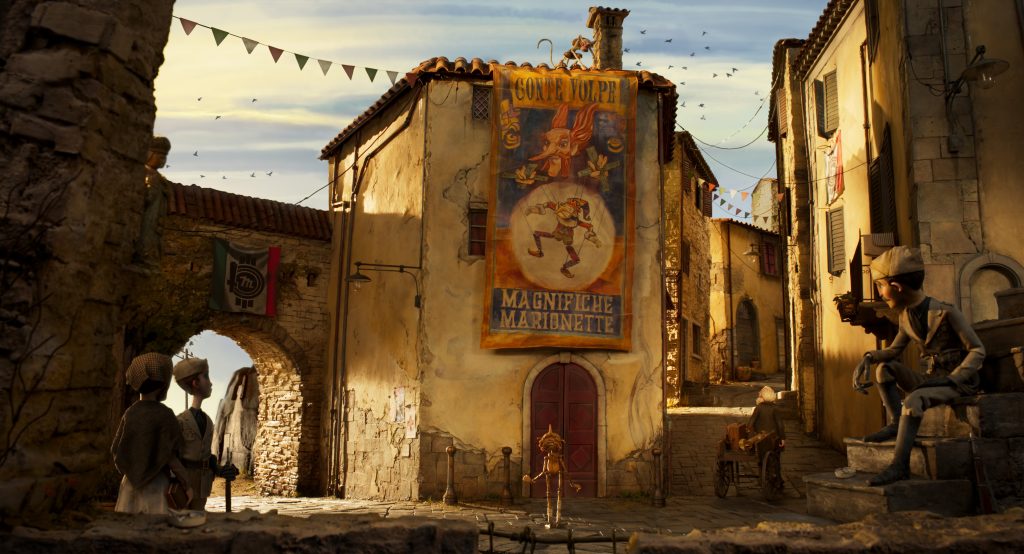
Passingham used the black and transparent creation as gobos in front of the key light to produce “an almost organic pattern”. Once a collaboration between the production designers and art director had determined the first elements of the Limbo world, the camera lighting team carried out tests with the patterned gobos.
“When Guillermo came to the studio to see it, I was nervous, but he said, ‘Great, let’s do it like that,’” says Passingham. “He’s a true collaborator, so everyone enjoyed fantastic teamwork between all departments. I haven’t been on a production with collaboration to that degree. Mark [Gustafson] was the on-site director and, especially during the pandemic, Guillermo didn’t travel as much so could not be on site, but we always had remote check ins, and he frequently briefed the animators in meetings in which I would discuss lighting.
“Although I’d never worked with Mark, we got on so well. He has a great sense of humour and is a real people person. Both Mark and Guillermo are just a joy to work with. They’re both excellent communicators and all of us love movies so much.”

While exploring lighting approaches, Passingham developed a technique he refers to as layered lighting which was deployed for multiple scenes including when Pinocchio rescues Geppetto from the water. Relying on methods typically used in live action to illuminate certain scenes, Passingham produced a hyperreal, but naturalistic feel to the stop motion that is rarely seen in the medium. “That scene was all the same piece of animation, but I shot it in more than one pass – an underwater pass with a gobo on it and movement of light coming through water and then there’s a pass which is a direct key light of the sun shining on them when they break through the water’s surface.”
A rough layout approximated where the surface of the water was so the animator knew when the characters were breaking through and could ensure their animation was correct. “We gave it two passes all the way through because parts of the characters’ bodies would always be underwater. VFX could then take the two very different colour passes – direct sunlight and underwater – and put them together once the CG water had been created.”

To illuminate a sequence that sees Pinocchio nearly burned to death by a torch-wielding Count Volpe, Passingham placed small LED lights inside Volpe’s torch to cast a flickering orange-red glow onto the characters in every frame. “We realised if we used LEDs in the torch, that would light up his face, other characters, and the surrounding areas as it moved around,” he says. “By combining those different exposures, and doing the moonlight as a separate pass, we could combine everything in post-production to make it look really fluid and like that light was really coming from the torch.”
The layered light effect impressed del Toro. “Getting Frank to do the cinematography is like getting Vittorio Storaro in live action,” he says. “The way Frank layers the light in several passes that then get sandwiched together in an impeccable way is marvellous.”
In the same way light constantly moves in the real world, Passingham wanted to achieve this in the stop motion dimension with gaffers Jean Margaret Thomas, Noah Dille, Michael Gall and Ivan Cantu-Villareal working in tandem with the motion control team. “When shooting some daylight scenes, we worked with large gobos and sometimes, if it’s a landscape, town scene, or wide scene and we wanted a little bit of movement of light, in front of the key light we would use a tracker and 10 by 5-foot frame with a transparent heat shield on it,” says Passingham. “My gaffers created various cloud-shaped gobos, and we tracked that in front of the key light to create subtle clouds. When working on a scene set on a breezy day, for example, the movement of light can make the whole scene breathe.”

Being crafty with kit
Passingham shot previous films such as Kubo and the Two Strings (2016) with the Canon 5D, finding it to be a “strong workhorse capable of really high resolution”. Despite a variety of mirrorless cameras having been recently released, the cinematographer was cautious to use them “because the mirror protects the sensor which is important for stop frame animation, especially when there’s dust in the studio and a shot might take three weeks to capture.”
Despite wanting to test mirrorless camera options, experimenting with them thoroughly would require testing for a longer period than was available. Therefore, Passingham chose the Canon 5D Mark IV – supplied by Adorama – as he was already confident in the previous models’ capabilities. He teamed it with a mixture of Nikon, Zeiss, and LAOWA lenses, maintaining good continuity despite using lens models from three manufacturers.

Although the original plan was to shoot with 34 units and 17 animators with a bounce unit, more than 60 units in Mexico and Portland were required for the shoot which spanned more than a thousand days. “As we needed many lenses and cameras the wide range of Nikon lenses we used – including the Micro NIKKOR 55mm f/2.8 – were an ideal choice as they were affordable but delivered great quality. I also sourced as many Zeiss lenses as I could, especially the fantastic Zeiss 25, 35 and 28mm Distagons which we used a fair amount.”
Most of the lenses were purchased second hand, 60% on eBay from Japan, some of the Nikons came from Grays of Westminster in the UK, some from local camera stores in Portland but most came from KEH in the US.
A friend of Passingham’s who shoots natural history introduced him to the LAOWA 15mm f/4 macro and 100mm f/2.8 Ultra Macro APO macro lenses which had been perfectly suited to capturing close-up shots of insects. During testing, he was impressed by the wide-angle options that were available.

Passingham also knew the production would demand more lighting fixtures than was originally planned. Deciding all key light would be tungsten and all bounce light or indirect light would be LED, the cinematographer faced limitations as working with new LED fixtures would eat into the budget. Luckily, as many studios were moving to LED fixtures and selling their tungsten lights, Passingham bought them at a reduced rate and converted some to LED to stretch the kit budget further. Nearly all tungsten key lights were ARRI 5Ks, 2Ks, 1Ks and 650s.
Some lights were built from scratch, and bounce lights were created from steel buckets with LED emitters in the bottom. Guttering from a hardware store with strips of LED attached evenly illuminated green screens. Predominantly green screen was used for shots featuring a sky, but occasionally a printed sky or background was used if little landscape would be seen or would be out of focus, to save money on VFX.

The magic of stop motion
The motion control team excelled at programming often complex moves and building rigs. Once a move is created it needs to be blocked with the animator, so Passingham likes to involve the animator as early as possible “because you want to know exactly what a character will look like in the light in each part of the scene, and you must be particular about the way the light hits them.”
David Trappe and Matt Emmons from the motion control team built additional motion control rigs and used second-hand equipment such as track and a huge rotator. “When planning the scene with Carlo and Geppetto eating a candlelit meal followed by a reverse sequence where you meet Carlo in the early days, we wondered how to do this with motion control,” says Passingham. “We needed to really rotate around the table and the rig would get in the way of the animator and the light.”
The second-hand rotator offered the solution as it was large enough for the whole set to be placed on it. All lights needed to be connected to the set, and the crew discovered that by using smaller lamps, the whole candlelit scene could be rotated.

Passingham also enjoyed a creative collaboration with senior colourist at Picture Shop, Jason Fabbro. “I loved Jason’s previous work, and he has a fantastic eye, is quick, and a joy to work with in the grade,” says Passingham. “I didn’t know until after the grade that Guillermo never normally has his DP in the colour suite and usually does the grade himself. Apparently, I was the first one which was incredibly exciting.”
The grade was intensive, especially as some complex water shots demanded additional work from VFX so were graded at a later stage. “When a puppet interacts with water it will always be insanely difficult for visual effects, but the team at Mr. X who handled the VFX were excellent,” says Passingham. “They visited us early on so we could discuss the way we would shoot the film and how we would work with multiple passes.”

Passingham was delighted that del Toro, who had dreamed of reimagining Pinocchio for so many years, wanted to tell such a treasured story using stop frame animation. “The whole story is about bringing a puppet to life, so it seemed stop frame animation was the perfect vehicle for this film. It couldn’t be better,” says the cinematographer. “The magic of stop frame animation for me is it’s a miniature world, but you can still light it like a live action movie, just on a smaller scale. I adore working in this medium and long may we continue telling stories in this way.”
One of del Toro’s aims when making the film was to prove that “animation is not a genre for kids, that it is a medium – an art form.” The director concludes: “Animation offers us the chance to see a supreme act of creation and recreation: to present to you the world and the human spirit through the hands of hundreds of artists and a very personal gaze… to present the beauty and poignancy of the human spirit in a clear, powerful song to life, love and loss.”
